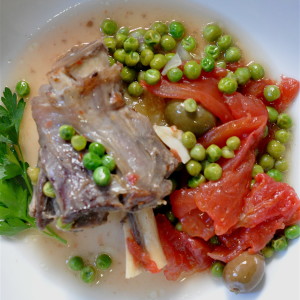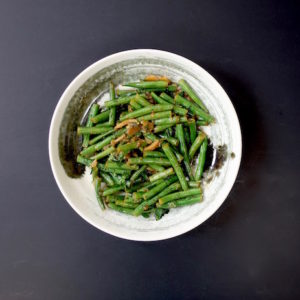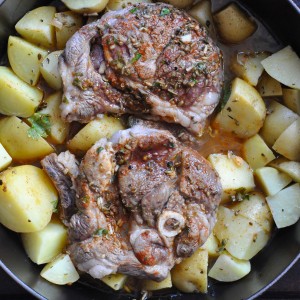Paula Wolfert’s Lamb Tagine
Wait a minute! Weren’t we here already? Indeed we were, just about a year ago to the day. But the recipes are different–Lamb Tagine With Preserved Lemon hails from Claudia Roden’s marvelous Book Of Middle Eastern Food. Today’s tagine comes from another seminal cookbook, Paula Wolfert’s Couscous And Other Good Food From Morocco.

Fifty years later, Paula Wolfert is losing her memory to a rare kind of Alzheimer’s Disease. It is incumbent on us, her adoring fans, to keep her flame.
So when a good friend and loyal reader, himself a professional writer, appointed himself unpaid proofreader of the IK, catching all manner of spelling errors and worse, I asked how I could thank him.
A recipe utilizing preserved lemons and lamb was requested. What better source than Paula Wolfert, who along with Claudia Roden, brought Moroccan food to English-speaking readers?

Before moving on, let’s discuss these preserved lemons for a moment. These were made in January 2015 from the lemons in my yard. The white stuff in the jar–a technical term–is harmless; Eugenia Bone, writing in Well-Preserved, explains it is “a precipitate of salt, oils, and whatever from the pith.”
Returning to our regularly scheduled post.
It is difficult, if not impossible, to understand the impact of Couscous And Other Good Food From Morocco today. Even readers living in locales where “exotic” ingredients or “foreign” markets are scarce need only an internet hookup and a credit card to get the world delivered to their doorstep.
Not so in 1973. Consider Gael Greene’s introduction to Couscous And Other Good Food From Morocco. Invited to Wolfert’s for dinner, she knew exactly what to bring:
Do I bring flowers? Wine? Bonbons? No, I bring cilantro (green coriander) because fresh cilantro is the badge of our friendship. (She can’t buy it in her neighborhood. I can. A friend would not cross town without cilantro.)
Cilantro, an herb so utterly prosaic today that we don’t give it a second thought, much less require an explanation. Cilantro is pedestrian enough to be found less than a block from my home, in not one but three markets. Gift today’s host or hostess with cilantro and be greeted with astonishment. Or worse.
I have to laugh. Cilantro is in fact so prosaic that in adding photographs –the final step before posting–I realized I had none of cilantro. Two days ago, it was the parsley that caught my eye.

Like all stews–regardless of what they’re called or what part of the world they come from–this one is best when built rather than tossed together. That said, if time is not on your side, Wolfert herself writes that the ingredients may all be placed in the pot, brought to a boil, and simmered for two hours.

Which brings me to cooking method: lacking home ovens, Moroccans cooked their meals over burners. Baking was sent out. When stewing or braising, I prefer starting the dish stovetop, then moving it to a low oven–325-350F. Lamb Tagine will also cook beautifully in a slow-cooker, should you have one.
A few other random mutterings: the original dish calls for saffron, omitted here not only due to expense but because–gulp–I am not fond of it. Maybe I’ve never had good saffron, but I’ve always found it harsh. I’ve also reduced the amounts of onion, because of John. What onion I did use required grating, and got that way in a food processor, because I find box graters instruments of torture.

Finally, the preserved lemon. Wolfert’s recipe calls for two whole lemons, but they are used decoratively rather than being integrated into the dish. Claudia Roden’s recipe calls for mincing the peel and adding it in, maximizing taste. To that end, I used one whole preserved lemon, rinsed, chopped, and stirred in, peel, flesh, and all.
Don’t let a lack of preserved lemons deter you. Short of whipping up a batch yourself, you can buy them at Middle-Eastern markets and some well-stocked gourmet markets. Or you can just use lots of fresh lemon juice, which this recipe calls for anyway.

(Not lemons. But the better photograph.)
Paula Wolfert’s Lamb Tagine
Minimally adapted from Couscous And Other Good Food From Morocco
yield: 2-3 servings
Amounts easily scaled upward
Preparation time: 2-3 hours stovetop or in the oven
4 hours in a slow-cooker
1 1/2 pounds lamb shoulder or lamb stewing meat with some fat, cut into chunks
1/4 cup olive oil
1/4 teaspoon turmeric
1 teaspoon ground ginger
1 teaspoon hot paprika (substitute mild if preferred)
1/2 teaspoon freshly ground black pepper
1/4 teaspoon ground cumin
1 teaspoon fine sea salt
1/2 cup grated onion
1 cup water
1/4 cup finely minced parsley and cilantro leaves
1 cup pitted olives: Kalamata, Gaeta, or another sharp Greek or Italian variety
1 preserved lemon, rinsed and finely minced
Juice of 1 fresh lemon, Meyer if possible
Note: Slow cooker instructions at bottom of recipe.
If you are making the tagine in the oven, preheat to 325F.
You will need an oven safe, lidded casserole, tagine, or enameled cast-iron pot that holds about 4 quarts.
Bring the lamb to room temperature. Trim any large pieces of fat and discard.
Place the cooking vessel on a burner over low heat. Pour in the olive oil and add the turmeric, ginger, paprika, pepper, cumin, salt, and onion.
Add the lamb and cook very gently, allowing it to brown lightly. Add the cup of water and bring to a boil. If cooking in the oven, cover and place pan in oven for an hour, adding water if needed.
If cooking tagine stovetop, cover and cook over low heat for an hour, adding water if necessary.
I did not need to add water until nearly the end of cooking, and then it was 1 1/2 cups.
After one hour, add the parsley and cilantro. Continue simmering until lamb is tender, another 1-2 hours. Keep an eye on the water level, adding when necessary.
In the final 15 minutes of cooking, add the minced preserved lemon, the fresh lemon juice, and the pitted olives.
Taste for seasoning: you may wish to add a little more preserved lemon.
Serve with couscous, rice, salad, or flatbreads.
Notes:
If you prefer, instead of adding the herbs at the one-hour point, toss them in at the beginning and cook everything at once.
Sauce may be reduced by removing lamb with a slotted spoon and boiling liquid over high heat.
Wolfert writes that a tablespoon of tomato sauce is an excellent addition.
Slow Cooker instructions: Add all the ingredients except lemons and olives to insert. You may need a little more water; it should come 3/4 up the pot but not swamp the lamb. Turn the cooker to the 4 hour or low setting. Fifteen minutes before turning off the pot, add the fresh lemon juice, the minced preserved lemon, and the olives.
Tagine only improves if you allow it rest overnight.
Leftovers keep well in the refrigerator three-four days (don’t go past four days). I find stews tend to turn mushy when frozen.





